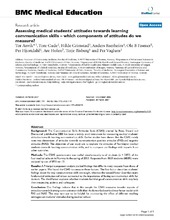| dc.contributor.author | Anvik, Tor | en_US |
| dc.contributor.author | Gude, Tore | en_US |
| dc.contributor.author | Grimstad, Hilde | en_US |
| dc.contributor.author | Bærheim, Anders | en_US |
| dc.contributor.author | Fasmer, Ole Bernt | en_US |
| dc.contributor.author | Hjortdahl, Per | en_US |
| dc.contributor.author | Holen, Are | en_US |
| dc.contributor.author | Risberg, Terje | en_US |
| dc.contributor.author | Vaglum, Per | en_US |
| dc.date.accessioned | 2007-07-23T13:21:01Z | |
| dc.date.available | 2007-07-23T13:21:01Z | |
| dc.date.issued | 2007-03-30 | eng |
| dc.Published | BMC Medical Education 2007 7:4 | en |
| dc.identifier.issn | 1472-6920 | |
| dc.identifier.uri | https://hdl.handle.net/1956/2325 | |
| dc.description.abstract | Background. The Communication Skills Attitudes Scale (CSAS) created by Rees, Sheard and Davies and published in 2002 has been a widely used instrument for measuring medical students' attitudes towards learning communication skills. Earlier studies have shown that the CSAS mainly tests two dimensions of attitudes towards communication; positive attitudes (PAS) and negative attitudes (NAS). The objectives of our study are to explore the attitudes of Norwegian medical students towards learning communication skills, and to compare our findings with reports from other countries. Methods. The CSAS questionnaire was mailed simultaneously to all students (n = 3055) of the four medical schools in Norway in the spring of 2003. Response from 1833 students (60.0%) were analysed by use of SPSS ver.12. Results. A Principal component analysis yielded findings that differ in many respects from those of earlier papers. We found the CSAS to measure three factors. The first factor describes students' feelings about the way communication skills are taught, whereas the second factor describes more fundamental attitudes and values connected to the importance of having communication skills for doctors. The third factor explores whether students feel that good communication skills may help them respecting patients and colleagues. Conclusion. Our findings indicate that in this sample the CSAS measures broader aspects of attitudes towards learning communication skills than the formerly described two-factor model with PAS and NAS. This may turn out to be helpful for monitoring the effect of different teaching strategies on students' attitudes during medical school. | en_US |
| dc.language.iso | eng | eng |
| dc.publisher | BioMed Central | eng |
| dc.title | Assessing medical students’ attitudes towards learning communication skills – which components of attitudes do we measure? | en_US |
| dc.type | Peer reviewed | |
| dc.type | Journal article | |
| dc.identifier.doi | https://doi.org/10.1186/1472-6920-7-4 | |
| dc.identifier.cristin | 372856 | |
| dc.subject.nsi | VDP::Medisinske Fag: 700 | nob |
| dc.subject.nsi | VDP::Samfunnsvitenskap: 200::Pedagogiske fag: 280 | nob |
